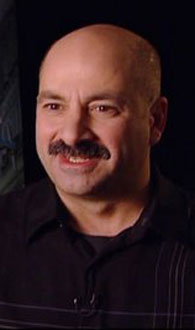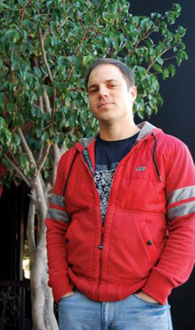This morning, DC Entertainment named Jim Lee and Dan DiDio as the new co-publishers of DC Comics, and Geoff Johns as Chief Creative Officer (a new position)–all three of them longtime company insiders. Here’s a few thoughts about what their new roles might mean.
(More on Techland: DC Entertainment Announces Its Superhero Execs)
On Jim Lee:
 I think it’s fair to say that this means that we won’t be getting many more Jim Lee-drawn comics in the near future. That’s a totally reasonable tradeoff. Over the past few years, Lee’s imprint WildStorm has effectively been DC Comics’ research-and-development arm: an incubator for developing talent, and a place to experiment with formats and content. Understandably, that means they’ve had a lot of commercial misfires (the WildStorm Universe line has all but totally run aground at this point), but they’ve also taken some risks that have paid off handsomely: the Heroes collections, Gears of War (which reputedly sells much better outside the direct comics market than within it), the America’s Best Comics line (before Alan Moore severed his ties with DC). Lee has a reputation for being very creator-friendly–when I interviewed Kevin O’Neill a few months back, he spoke very highly of Lee’s midwifing of the troubled League of Extraordinary Gentlemen: The Black Dossier project.
I think it’s fair to say that this means that we won’t be getting many more Jim Lee-drawn comics in the near future. That’s a totally reasonable tradeoff. Over the past few years, Lee’s imprint WildStorm has effectively been DC Comics’ research-and-development arm: an incubator for developing talent, and a place to experiment with formats and content. Understandably, that means they’ve had a lot of commercial misfires (the WildStorm Universe line has all but totally run aground at this point), but they’ve also taken some risks that have paid off handsomely: the Heroes collections, Gears of War (which reputedly sells much better outside the direct comics market than within it), the America’s Best Comics line (before Alan Moore severed his ties with DC). Lee has a reputation for being very creator-friendly–when I interviewed Kevin O’Neill a few months back, he spoke very highly of Lee’s midwifing of the troubled League of Extraordinary Gentlemen: The Black Dossier project.
Lee seems to be comfortable with new technology in a way that the DC establishment hasn’t shown itself to be in the past: he’s one of the forces behind the DC Universe Online project, and likely to lead DC’s publishing into the digital realm. He’s also very much a West Coast guy–if, as has been rumored for a while, DC moves its headquarters to California, he’s been set up there with WildStorm for years. It’ll be interesting to see how the “co-publisher” position works out with Lee and DiDio, though–when even the press release notes that “there’s going to be some easygoing but frank, healthy discussion about how we can accomplish these goals,” it’s evident that they’ve got a couple of different visions for the company.
On Dan DiDio:
 DiDio has generally treated his job as DC’s VP – Executive Editor as preaching to the faithful: holding on to the readers that the DC Universe line already has, and attracting readers drawn to that line’s current approach, rather than expanding the sorts of material DC publishes. At its best, that’s meant clever publishing initiatives like 52, bringing in some big-name writers from other media, and giving talented creators–especially Geoff Johns and Grant Morrison–license to recast and upgrade some moribund properties. He’s made a point of interacting with the vocal edge of the reader base, online and at conventions, and cheering on the troops. But DiDio has a habit of drowning any half-successful project in a sea of knockoffs and tie-ins: see, for instance, the Countdown disaster, which was built on a sharp insight–that it would be fun to have a big comics serial proceed at the pace of comics distribution–and totally flubbed the execution. He’s also tended to haul out random bits of ancient intellectual property, possibly in the hopes that somebody’s still nostalgic for it (e.g. the Red Circle line, which is only a few months old and already scuffing the bottom of the sales charts).
DiDio has generally treated his job as DC’s VP – Executive Editor as preaching to the faithful: holding on to the readers that the DC Universe line already has, and attracting readers drawn to that line’s current approach, rather than expanding the sorts of material DC publishes. At its best, that’s meant clever publishing initiatives like 52, bringing in some big-name writers from other media, and giving talented creators–especially Geoff Johns and Grant Morrison–license to recast and upgrade some moribund properties. He’s made a point of interacting with the vocal edge of the reader base, online and at conventions, and cheering on the troops. But DiDio has a habit of drowning any half-successful project in a sea of knockoffs and tie-ins: see, for instance, the Countdown disaster, which was built on a sharp insight–that it would be fun to have a big comics serial proceed at the pace of comics distribution–and totally flubbed the execution. He’s also tended to haul out random bits of ancient intellectual property, possibly in the hopes that somebody’s still nostalgic for it (e.g. the Red Circle line, which is only a few months old and already scuffing the bottom of the sales charts).
DiDio’s tenure has been marked by extensive, rapid creative churn–there are relatively few DC Universe titles that have been able to hold on to a consistent creative team or approach for more than a few months, and DC hasn’t been doing terribly well lately at attracting A-list creators (or developing new creators into A-listers). To the extent that being DC’s co-publisher means fanning the flames of support for characters that were created decades ago, and understanding comics culture as we know it, he’s very well positioned; it’s less clear that he’s going to be able to open the company up to broader creative risks and rewards, or expand the way comics are experienced, like Paul Levitz did.
(More on Techland: Read Douglas’ thoughts on comics in his column “Emanata” on Techland each Friday)
On Geoff Johns:
 Johns has a tendency to spread himself very thin: at the moment, he’s writing Green Lantern, Blackest Night (to be followed by half of Brightest Day), various iterations of The Flash and the upcoming Batman: Earth One project, as well as the odd miniseries (and part of this week’s issue of Tiny Titans), and his Adventure Comics revival more or less crashed on takeoff. That could be a problem if he’s going to have a hand in even more of DC’s publishing projects. But he’s also an excellent team player, from all reports, and infectiously enthusiastic about the DC Universe material for its own sake; if the goal for a “chief creative officer” is to guide the story direction of that material, he’s been doing very well with the titles he’s been writing. (His sensibility is essentially “wouldn’t it be cool if…?”–which is ideal for this job. ) He’s another West Coaster, and well-connected in Hollywood–that, of course, is where a lot of the real money is for mainstream comics, and for DC Entertainment in particular.
Johns has a tendency to spread himself very thin: at the moment, he’s writing Green Lantern, Blackest Night (to be followed by half of Brightest Day), various iterations of The Flash and the upcoming Batman: Earth One project, as well as the odd miniseries (and part of this week’s issue of Tiny Titans), and his Adventure Comics revival more or less crashed on takeoff. That could be a problem if he’s going to have a hand in even more of DC’s publishing projects. But he’s also an excellent team player, from all reports, and infectiously enthusiastic about the DC Universe material for its own sake; if the goal for a “chief creative officer” is to guide the story direction of that material, he’s been doing very well with the titles he’s been writing. (His sensibility is essentially “wouldn’t it be cool if…?”–which is ideal for this job. ) He’s another West Coaster, and well-connected in Hollywood–that, of course, is where a lot of the real money is for mainstream comics, and for DC Entertainment in particular.
One potentially worrying note: his introductory note goes on at length about DC properties (and curiously mentions Y: The Last Man, which last I looked was still copyrighted and trademarked by Brian K. Vaughan and Pia Guerra), but doesn’t have much to say about creators–aside from Martin Campbell and Ryan Reynolds. That would make more sense if Johns had been named to a specifically media-based role, but I’d hope that someone who’s got “creative” in his job title would focus more on the real-world people who write and draw the material DC publishes, and on figuring out how to create new “characters and worlds,” rather than milking a few more drops from the old ones.
More on Techland:

